|
|
| |
|
| |
|
| |
|
| |
|
| |
|
| |
[This
is Part 3 of a 4-Part series]
Part I of this essay documented how the Museum of the Confederacy
has provided a home for neo-Confederates like Ludwell
Johnson and worked with neo-Confederate organizations;
Part II explained that the MOC obscures the issue of slavery
in its hagiographic portrayals of Confederate leaders.
These activities, however, support what can be considered
the primary function of the Museum: to create and reproduce
Confederate national identity. To achieve this goal the
MOC is both explicit and implicit (‘banal’) in its nationalism
and efforts to sacralize the Confederacy.
In the 20th and 21st centuries nationalism, as an ideology
for organizing the world, is so dominant that it is difficult
to imagine other forms of geopolitical organization. Nations
seem to be concrete and objective realities, not social
constructs. Yet, the idea of nationality and nations is
a relatively recent idea that many commentators believe
began in 18th century Europe. National identity is produced
through various processes. [1] From national anthems, flags and pledges
of allegiance to instruction in the schools and history
textbooks, the stuff of nationalism saturates everyday
life in a manner that can be referred to as “banal nationalism.” [2]
. This section of my essay will examine the MOC’s explicit
and banal practices of producing Confederate national
identity.
Originally, museums were conceptualized as microcosms of
the world. In the 19th century, as the modern nation-state
developed in Europe, museums were seen as instrumental
in creating national identities. Indeed, they are still
employed by relatively new nations as well as established
nations to create national identity. As Martin Prösler
explains in his paper, “Museums and Globalization”:
In this context the cosmological tradition of the museum
has meaning for the nation state, and is at the same time
one of its richest symbols.
The museum takes on the form of a complete microcosmic representation
of a sovereign nation state. The collected objects in
the museum document a human community extending in time
and space: the nation. They also document by their (territorial)
origins the state’s spheres of political influence.
The building contains representatively everything in
the state territory – and in this way becomes itself
a symbol of a power relationship. The museum embodies
the nation state while at the same time providing it
with a place in the general order of things. ‘A national
heritage is a nation’s umbilical cord’ – a metaphor
employed by Assogba of Benin. The task of the museum
is to preserve this national heritage within the course
of time, handing it down to the succeeding generations.
… [3]
Flora E.S. Kaplan further explains that museum, “collections
have played important roles in creating national identity
and in promoting national agendas”. [4] In the book, “Heritage & Museums: Shaping
National Identity,” edited by J.M. Fladmark, multiple
examples museum practices of using objects to create Scottish
national identity are given. [5]
The Museum of the Confederacy is neither the Museum of the
Civil War nor the Museum of the Civil War in the Former
Slave States.
[6] It is the museum of a nation that attempted
to create itself in 1861, before being vanquished in 1865.
Inherently the MOC’s actions serve to create a microcosm
of the Confederacy, not least by its self-definition as
the Museum of the Confederacy, but also
in the imagination of people coming into contact with
the MOC whether by visiting, being members, reading its
publications, or other means.
EQUATING THE SOUTH WITH THE CONFEDERACY
As described in Parts I and II of this series, the Museum
had a long-established annual ball that was, until very
recently, named “Celebrate South.” The ball was usually
tied to a specific state, implicitly asserting that the
“Confederacy” and the “South” are one and the same, thus
claiming a territory for this imagined Confederate nation.
The Museum of the Confederacy has also held numerous exhibits
which conflate “Southern” and “Confederate” identity.
This equation of the “South” and the “Confederacy” has
been part of the MOC since its opening its doors in 1896.
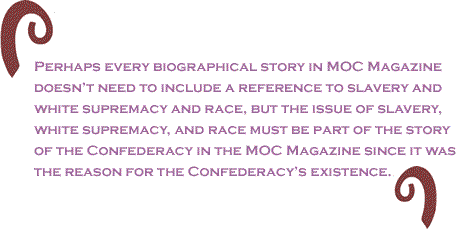
At its foundation the MOC “was separated into rooms dedicated
to the collections amassed by each of the eleven undisputed
Confederate states.” Additionally, the MOC recognized
the territorial claims made by the Confederacy by having
rooms for Missouri, Kentucky, and Maryland, states that
were not part of the Confederacy. Additionally there was
a “Solid South Room.”
[7] Though the practice of having these rooms
as an organizational basis for the governance of the MOC
is no longer used, it shows that the physical layout of
the MOC was meant to be a microcosm of Confederate territory.
146 years later, in 2011, the MOC still routinely uses
“South” and “Confederate” interchangeably, distributing
an email newsletter titled The Southern Sentinel,
that positions the MOC as a protector of the “Southern”
and suggesting that there is some threat to this. In a
Spring 2011 article in the Museum’s Magazine, MOC
historian and director of library and research John Coski
writes, “As the South sent her sons off to war in 1861
…” thus making the Confederate war effort a domestic effort
of all “Southern” homes. [8] Such language asserts that “Southern” and
“Confederate” identities are the same thing. They are,
of course, far from being the same. Many white residents
of “southern” states in the 1860s opposed the Confederate
government and nation; most African-American residents
of “southern” states were slaves.
The merging together of “southern” and “Confederate” identities
could result in anyone who identifies themselves as a
“southerner” identifying with the Confederacy. Given that
a great many people self-identify as being southern, often
strongly, this is a powerful strategy through which the
MOC can create and assert a Confederate national identity.
EXPLICIT NATIONALISM
Confederate Flags
National flags are by definition national identifiers. Confederate
flags are those flags adopted by the Confederacy in its
quest to be a nation and were intended to serve as a symbol
of the Confederate nation. The conservation of flags,
like the conservation of any historical artifact, is a
legitimate activity for a museum. However, flags are powerful
instruments of national identity and act as such - it
is the purpose for which they designed. The MOC uses
Confederate flags as symbols that both assert and reinforce
Confederate national identity. The MOC’s flag conservation
program began in 1993, two years after the opening of
the “Before Freedom Came” exhibition, and the year in
which Ludwell Johnson’s speech indicated that neo-Confederates
had gained significant influence at the museum. Commenting
on the launch of the flag program, a 2010 Museum of
the Confederacy Magazine article stated that the museum,
“continues to bring these splendid banners back to life.”
[9] The question can be asked, splendid for
whom? Displaying Confederate national identity, supporting
it, and reinforcing with Confederate flags, from national
to regimental, is one of the MOC’s primary activities.
Long unused flags are brought “back to life” at the MOC
in more ways than one. Not only are the flags physically
restored, they become objects of Confederate identity,
veneration, and, implicitly, national restoration.
In a Winter 2006 MOC Magazine article describing its
flag conservation program, Confederate flags are referred
to in the title as “noble colors,” making clear the MOC’s
motivation and purpose for flag conservation. In the article,
Dr. Martin Tant, past Commander of a Sons of Confederate
Veterans (SCV) camp, visits the MOC to view a Confederate
regimental flag, and decides to sponsor the flag’s preservation.
“It was truly an amazing feeling,” Tant states, “to be
in the presence of the noble colors that my third great-grandfather
, Pvt. Harrison Tant, fought under.” The article further
reports on flag conservation sponsors and Confederate
re-enactors James and Becky Plummer. The Plummers undertake
Confederate memorial projects, the article quotes, “with
Love, Honor, and Respect for our boys in Grey who fought
for a truly noble cause.” The article concludes, again
quoting Tant: “I look forward to seeing the noble flag
of the 41st Georgia Infantry Regiment displayed in its
righteous place of honor in The Museum of the Confederacy.”
A 2008 MOC Magazine article discussing raising
funds for the flag restoration and shows a Confederate
re-enacting unit standing, crouching and kneeling around
a reproduction of a battle flag of a Confederate unit
with the restored original in the background.
[10]
A 2009 MOC Magazine article repeats Tant’s reasons,
telling the reader, “Dr. Tant sponsored the flag’s restoration
in honor of the men of the regiment, particularly his
3rd great grandfather Pvt. Harrison Tant.” [11]
Outlining that “a trend of descendants, reenactors, and researchers
[are] deciding to translate their interest and dedication
to a flag into sponsorship,” Rebecca Rose explains that
although funding is undertaken primarily by groups, there
are an increasing number of individual sponsors who make
donations “to conserve a fragile flag in what is truly
a labor of love.” In detailing the processes and costs
of flag conservation, Rose never challenges the characterization
of these flags as “noble,” nor does she question assertions
that the effort for Confederate secession was “a truly
noble cause.” Instead the MOC positions itself in Rose’s
article as a “righteous place of honor” for Confederate
flags. [12]
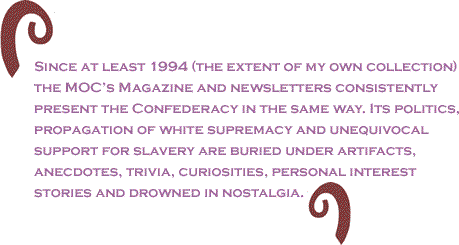
In the Summer 2011 issue of MOC magazine, another
article about flag restoration titled, “A ‘Bright and
Lasting’ Tribute: The Conservation of the Caroline Greys
Flag,”concludes with a quote from a newspaper that a preserved
flag was “to achieve bright and lasting honors.” [13] The MOC originally received the flag discussed
when it was given to the Relic Committee of the Ladies’
Hollywood [14] Memorial Association. The article is reverential
towards the flag, treating it as if it was a holy relic.
Funds for this flag’s conservation, curator Catherine
Wright explains, were provided by Floyd Tyson, who “had
grown up in Richmond, steeped in stories and memories
of the [1861-65 Civil] war,” the Caroline Greys and, “Although
he had no ancestors who fought beneath the flag of the
Caroline Greys, he was deeply respectful of the sacrifices
made by the men who did.” [15]
A 2004 Confederate Veteran article about a SCV visit
to the MOC, quotes MOC President and CEO , Waite Rawls
saying:
“… We have many, many requests from individuals to see a
particular flag that their ancestor carried or fought
for, and we try to grant everyone’s request. There have
been many emotional moments in the flag vault.”
This article, by Henry E. Kidd, SCV Commander of the Army
of the Northern Virginia Department urges SCV members
to support the MOC:
Gentlemen, our ancestors cried when they surrendered their
flags 140 years ago, and their descendants still cry today
at the sight of these flags. I wonder how many of us will
cry when what we have taken so long for granted is lost
to us forever?
[16]
Evidently, such appeals are successful. One photograph of
two restored Confederate flags, published by the MOC in
2008 shows them alongside a Virginia Confederate Reenactment
unit, wearing Confederate military dress, whose members
together donated $42,500 to the MOC to conserve the flags.
Quoting the caption for the picture, “‘The dedication
of this group to these flags is truly inspiring,’ observed
President Waite Rawls.”
[17]
Numerous other articles in MOC publications make the same
point, namely that conserving flags is expensive, but
essential, work of the museum. Thus, the MOC’s restoration
of Confederate flags along with its storage facilities
and policies facilitating their conservation and observation,
together treat these flags as if they were sacred objects.
As such, the MOC provides the location, the symbols, and
the means for the execution of deeply emotional reaffirmations
of Confederate national identity. The banners are brought
back to life in more ways than one.
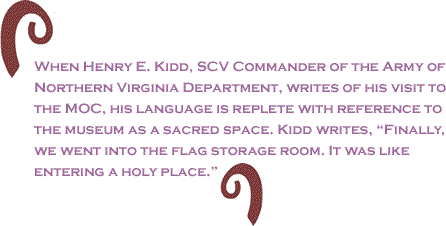
Yet, despite this reverence for flags and the work and cost
of their conservation, there is one flag in the MOC’s
collection that museum publications do not discuss: a
Ku Klux Klan flag given to the MOC by the North Carolina
Division of the United Daughters of the Confederacy (UDC).
On this historic flag, the MOC stays silent.
Selling Confederate Flags
Flags are clear markers of national identity and the MOC,
and its store, The Haversack, sells Confederate flags
both at the museum in Richmond and through its MOC
Magazine, enabling visitors and readers to acquire
these symbols of national identity. A visitor to, or member
of, the MOC is given the opportunity to purchase numerous
objects with various Confederate flags marked, affixed
or otherwise made part of the purchase. The most frequently
incorporated flag for purchase is the Confederate battle
flag. [18] Between 2005 and 2010, the Haversack catalog
in the MOC Magazine included, amongst other items,
a Confederate soldier nutcracker holding a Confederate
flag, [19] candles in jars with Confederate battle
flags on them,
[20] pocket watches with Confederate flags on
the inside of the boxes in which they are sold, [21]
a Confederate battle flag pillow, [22] a “Faberge-style” Confederate battle flag
egg, [23] a belt decorated with Confederate flags
along its length,
[24] a wooden “Treasure box” with a lid covered
with a Confederate battle flag,
[25] flag t-shirts, [26]
coins with Confederate leaders against colored Confederate
flags, [27] shot glasses, [28]
and glass Christmas ornaments of the Confederate battle
flag. [29] Also available were Confederate battle
flag belt buckles,
[30] baseball caps, [31]
coasters, [32]
blankets, [33]
computer mouse pads, [34] ties,
[35] and a “laser-etched crystal cube.” [36] Additional items can be found in The Haversack’s
online store,
[37] including a Confederate battle flag bandana,
fabric, bowtie, deck of cards, magnets, decals (of five
different types of Confederate flag), six different miniature
Confederate flags, five different Confederate flag sew
on patches and five different Confederate flag lapel pins.
These are just some of the objects available through The
Haversack on which the Confederate flag was prominent.
Many other objects incorporate Confederate flags in background
scenes, or as part of a larger design, yet all signal
Confederate national identity. Yet, curiously, despite
this list, until recently the MOC Magazine only
occasionally sold specialized Confederate flags that could
be flown outside. For example a Confederate blockade runner
was sold in just one MOC magazine issue,
[38] and a 1st National Confederate
flag decorated with an additional Irish harp was advertised
in another. [39] However, starting in Fall 2010, the MOC
Magazine has focused on selling a variety of 3
by 5 feet Confederate flags. These include, in Fall 2010
alone, the Confederate battle flag, Robert E. Lee’s headquarters
flag, the 1st, 2nd, and 3rd National Flags of the Confederacy,
and a thirteen star variant of the 1st National Confederate
flag. [40]
In addition to the flags, the Great Seal of the Confederacy,
a national symbol of the Confederacy, is also sold at
the MOC’s Haversack store in many forms. This includes
a Christmas tree ornaments,
[41] a coin,
[42] a mug,
[43] and a “Great Seal of the Confederacy full
color pin” to attach to your clothes,
[44] wine and beverage glasses. [45]
Further the MOC sells objects identified with Confederate
leaders. In addition to the activities honoring Robert
E. Lee and Jefferson Davis mentioned in the previous installments
of this article, the MOC also promotes Confederate leaders
as heroes through its Haversack store. From 2006 to 2011,
through the MOC Magazine, the Haversack has offered
an array of items identified with Confederate leaders.
The Winter/Spring 2007 issue alone offered Robert E. Lee
pictures, caps, mugs, pocket watches, key chains, commemorative
coins, etched crystals, shadow boxes of both Lee and “Stonewall”
Jackson U.S. Postage stamps, resin busts of Lee and Jackson,
Lee’s picture inside boxes for a jackknives and figurines
of Lee on a horse (both empty-handed and holding the Confederate
battle flag) and Lee with another soldier carrying a Confederate
battle flag. The same issue also offered “Stonewall” Jackson
knives, and pocket watches. [46] Other items offered in the last five years
include coasters with Jackson, Lee, Jefferson Davis and
his wife, Varina, and others; [47] Robert E. Lee blankets; a pewter sets of
Jefferson and Varina Davis, and one of their children;
Confederate general playing cards; Jackson, Lee and Mosby
lapel pins;
[48] Lee Christmas ornaments and keepsake boxes; [49] Confederate candles with portraits of Jackson,
Lee, and Mrs. Jackson;; a Jefferson Davis bust;
[50] “Defenders of Southern Pride” folding
knife sets with Lee, Jackson, Longstreet, J.E.B. Stuart,
or Nathan Bedford Forrest on the cover of the box; “Confederate
candy apple” Jefferson Davis candle;
[51] Lee paper weights; Lee pen and pencil holders;
magnets with Lee, Jackson, and other Confederate generals; [52] Confederate general James Longstreet, Confederate
general A.P. Hill, and Colonel John Singleton Mosby figurines;
“Lee Laser-Etched Crystal Cube,”
[53] “Last Meeting of Lee and Jackson” Christmas
ornament; commemorative coins of Davis, Lee, Jackson and
Stuart; Confederate shot glasses of Lee, Jackson, Stuart,
Longstreet, Pickett, and Johnson; [54] Lee Belt plate, available in in brass but
also gold-plated with a custom box for $500.00; and Carte
De Visite Magnets for Jackson, Lee, Davis, Varina Davis,
and Lee and Jackson together. [55]
Finally, in the online store you can purchase a Confederate
constitution, a “unique collectible” available as “a full-size
replica of the original Provisional Confederate Constitution,”
currently housed in the MOC, “ten feet in length and wound
on a large wooden roller,” making it not merely a souvenir
document but a sacred text. [56]
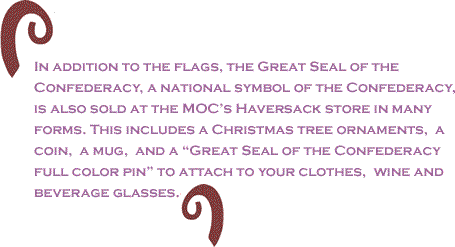
Any souvenir, and all these various knick-knacks, functions
as a “mnemonic device... the personal repository of a
special memory.”
[57] The purchase of flags, seals, and other
items of Confederate national identity allows individuals
to make a conscious decision to accrete to themselves
objects of Confederate identity. Together they enable
an individual to display an identification with the Confederacy
to others. In addition, buying these items from the MOC,
an institution that represents itself as a reliquary of
the Confederacy, gives them a special status. They are
more ‘authentic,’ more ‘sacred,’ more strongly representative
of Confederate national identity, than flags or other
objects purchased from commercial vendors. The MOC builds
Confederate national identity by selling it to consumers.
Shrine & Reliquary
The MOC fosters a Confederate national identity, employing
national symbols and heroes in this production, but these
activities are subsumed within the museum’s older practice,
namely a sacralization of the Confederacy, in which the
museum is a sacred place for the storage of Confederate
relics. Annabel Jane Wharton, in “Selling Jerusalem: Relics,
Replicas, Theme Parks,” explains:
A relic is the remnant of a history that is threatened by
forgetting. It records duration and postpones oblivion.
It offers reassurance that the past retains its authority.
It collapses time. A relic is a sign of previous power,
real or imagined. It promises to put that power back to
work. A relic is a fragment that evokes a lost fullness.
It is a part that allows the embrace of an absent whole.
It is the living piece of a dead object. It is an intensely
material sign entangled in a spiritual significance. A
relic avoids intrinsically valuable materials. It works
in part through the uniqueness of its survival. [58]
The language of relics, sanctity and pilgrimage pervades
much writing by and about the MOC. John Coski, for example,
in an article titled, “President Theodore Roosevelt Made
a Pilgrimage to the Confederate Museum,” simply through
the term “pilgrimage” implies that Roosevelt believed
in the Confederate cause (pilgrims, of course, act upon
their faith) and that a journey to the MOC is equivalent
of travel to a shrine or other holy place.
[59]
As mentioned above, the MOC acquired its initial artifacts
from a women’s reliquary committee, and Ludwell Johnson’s
characterization of the MOC as a “reliquary of the Confederacy”
is a theme that the MOC leadership continues to emphasize.
In a 2002 article, Coski explains the museum’s purpose:
In 1899, Mrs. Park appeared before the UDC’s national convention
to urge all Chapters to support the Museum and the work
that it only it could accomplish. She moved that each
Division appoint a Museum Committee (which it did) and
appropriate “a sum of money … for the running expenses
of this sacred treasure house, which have heretofore been
born [sic] by the Confederate Memorial Literary Society.”
Her appeal is as relevant and as compelling today as it
was then. (elision in Coski’s article.)
[60]
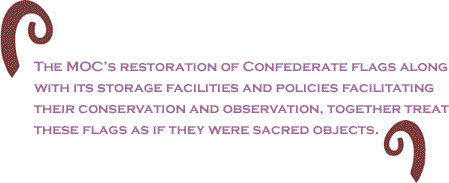
This theme of the MOC holding Confederate “treasure” was
repeated in the UDC’s 100th anniversary issue, which
announced about the MOC:
Among the treasures in our museum galleries you’ll find E.B.D.
Julio’s famous painting “The Last Meeting of Lee and Jackson,”
...as well as the world’s largest collection of Confederate
art, artifacts, and memorabilia. [61]
When Henry E. Kidd, SCV Commander of the Army of Northern
Virginia Department, writes of his visit to the MOC, his
language is replete with reference to the museum as a
sacred space. Kidd writes, “Finally, we went into the
flag storage room. It was like entering a holy place.”
Asking for SCV members to support the MOC, Kidd writes:
As members of the Sons of Confederate Veterans, we have been
charged with presenting the true history of the South
to future generations. To me, this also means that we
have to preserve the South’s priceless heirlooms. I learned
a lot about those priceless heirlooms recently on a visit
to the museum.
Kidd worries about the MOC’s financial problems: “To be honest,
I do not know what would happen to all the relics if the
museum is forced to cut back. I hate the thought of General
Lee’s HQ Flag or J.E.B. Stuart’s plumed hat falling into
the hands of Yankee museums.”
[62] This is the language of fear that sacred
objects will fall into ‘infidel’ hands.
Though no one has yet claimed miraculous cures and there
haven’t been any claims of statues shedding tears, the
operations of the MOC largely replicate, albeit in a more
modern version, medieval sacred sites at which visitors
came to view and adore sacred objects, relics, and purchase
some souvenir of their journey such as a prayer card.
Richmond was the capital city of the Confederacy and
the White House of the Confederacy where Jefferson Davis
as president of the Confederacy lived, is a highly charged
memorial space, and serves as a Jerusalem and temple for
this veneration of the Confederacy.
[63] Instead of boxes of stones from the Holy
Land brought back by pilgrims from Jerusalem, or ampules
with oil for sale to pilgrims,
[64] there are instead the myriad knickknacks
to be purchased from the MOC’s Haversack store. Instead
of pieces of the true cross, there are Confederate flags
lovingly restored with their care rivaling the work on
a religious reliquary.
The MOC collections are interpreted and organized as reliquaries.
This is exemplified in an issue of the Journal of the
Museum of the Confederacy which describes “The Museum
of the Confederacy’s Robert E. Lee Collection.” The issue
has an introductory hagiographical essay on Robert E.
Lee by Emory M. Thomas, professor emeritus of the University
of Georgia. The collection doesn’t have a bone or body
part of Lee in a jewel encrusted case like a medieval
relic, but does parallel these practices by listing a
least half a dozen pieces of Lee’s hair and hair from
his horse’s tail and mane. Further cataloged are dried
leaves and flowers collected from Lee’s coffin, a wreath
used at a memorial service for Lee, a piece of an apple
tree said to have shaded a meeting of Lee and Grant at
Appomattox, a chatelaine made from a button Lee gave to
an admirer, a linen handkerchief, a tureen, and numerous
other personal effects.
[65]
The Confederacy no longer exists as a state, but the MOC’s
collection of Confederate relics is very powerful strategy.
When coupled with the numerous souvenirs offered at The
Haversack MOC store, the MOC serves to facilitate the
creation of a metaphysical Confederate nation in the mind
of visitors and reader which the recipients of this vision
can inhabit. This residence in an imagined Confederate
nation is enhanced by the stories told in the pages of
MOC publications.
Stories of the MOC Magazine
The Spring and Winter 2010 issues of MOC Magazine
are typical in terms of their content, and their stories
are good examples of how the MOC represents the Confederate
experience to its followers.
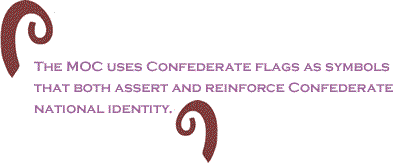
In the Spring 2010 issue, “Rich Collections Attest to Family
Ties of Three Confederate Generals,” by Ruth Ann Coski,
details the biographies of three Confederate generals:
Morgan, Hill, and Duke, each of whom had family ties to
the other. These detailed biographies, describe multiple
family events and experiences, from Ambrose Powell Hill’s
mother being “caught up in the Baptist revival movement”
of the 1840s and that “dancing, card games, and theatrics”
were banned from his teenage home. You can also learn
that Hill called his wife “Dolly” because “She had big,
blue eyes and struck Hill as being like a china doll.”
The article has numerous pictures of various artifacts such
as a shirt that Hill wore, a picture of Basil Duke, the
uniform worn by Morgan, and numerous other objects. According
to the article, “The Museum of the Confederacy has a rich
collection of Morgan and Hill artifacts,” given by descendants
of these individuals. What you will not learn is whether
any of the families or individuals owned slaves. what
they thought about slavery, or why they were fighting.
John Hunt Morgan died fighting for the Confederacy, yet
readers don’t know why he fought for the Confederacy.
Rather, these men’s postbellum marriages and careers are
detailed (if they survived the Civil War), but their views
and actions regarding Reconstruction and the reactionary
period of violent white terror is not detailed. Coski
notes that Basil Duke was the co-editor of Southern
Bivouac and editor of Southern Magazine. How
Duke treated the issues of the Ku Klux Klan and race in
those publications isn’t mentioned. Southern Magazine,
known as New Eclectic Magazine, in 1870 ran an
article “Notes on ‘Moral Discoveries in Africa’” which,
amongst other, things proposed that the African might
be a hybrid human-ape species, and proposed the further
hybridization of Africans with apes to make a more useful
worker. From the article:
And suppose the negro is to be regarded as a different species
of the genus homo. Whether that difference has grown up
by an independent evolution from lost tribes, which would
have shown the connection between the existing races of
men and also the chain of development from the quadrumana,
and whether these differences of the negro are due to
a later or less degree of this evolution (and in some
things we have seen the degree is greater), or due to
subsequent hybrisation with lost tribes of anthropoid
apes, can be of no real importance in this inquiry. If
the latter has been the process, it might be profitable
to consider the possibility of domesticating some still
untamed variety of gorilla or orang, with a view of obtaining
other crosses with still less brains and still better
developed physique for enduring labor and servitude, with
greater docility than our last experiment, this Bantu
African. [66]
Since Southern Magazine was one of the mainstream
magazines published in the southern states and became
the official organ of the Southern Historical Society
(a Lost Cause society of ex-Confederates) it might be
of interest to know the post-Civil War views on race of
ex-Confederates and in particular the views of the people
discussed in Coski’s article, particularly as Confederate
organizations such as the UDC, both past and present,
and today’s neo-Confederates have portrayed the Ku Klux
Klan during Reconstruction as heroic ex-Confederates.
The Tennessee Division of the United Daughters of the
Confederate in 2010 published a two page defense of the
Ku Klux Klan.
[67] This MOC Magazine article specifically
or the MOC in general doesn’t treat the issue of the ex-Confederates
during Reconstruction, but will in this article give details
as to the controversy of the proposal to name Lucy Lee
Hill, Ambrose Hill’s daughter, the title “Daughter of
the Confederacy” in 1898. The reader will learn that “Dolly”
Morgan Hill adopted her old nickname “Kitty” after her
husband died, and we can view the locket of Lucy Hill
in a picture, but the issues of race and slavery are not
discussed. [68]
Another article in the Spring 2010 MOC Magazine, “Stroll
Through The Streets or Through The Collections to Meet
the Women of Wartime Richmond,” by John Coski, is an account
of various white women in Richmond during the Civil War.
It includes anecdotes like that of Maggie Howell who,
not recognizing Mary Custis Lee (Robert E. Lee’s wife),
demanded that she leave Jefferson Davis’s pew at St. Paul’s
Episcopal Church. Two sisters known as “The Cary Invincibles,”
had “Starvation Parties” in support of the Confederacy
where they only served James River water as “Jeff Davis”
punch. Hettie Cary, we learn, “was widely hailed then
and since as the most beautiful belle of wartime Richmond.”
With pictures of the women in the article we learn of
social life in Richmond amongst the white elite. However,
the article omits the issue of slavery throughout. Who
did the work on putting on these social functions? Did
these women have slaves to help them with their social
life? Did these slaves have names? What were the views
of these white elite women of the Civil War, slavery and
race that led them to undertake activities to support
the war? What were the views of the slaves? The article
doesn’t say. [69]
Winter 2010’s, “Antebellum Scrapbook Reveals ‘Flowering’
of Young J.E.B. Stuart,” by Ruth Ann Coski describes Stuart’s
collecting of feathers and flowers in as much detail as
his career. Pages are devoted to photographs of items
he collected, yet the article, as it typical of the MOC,
elides slavery:
Stuart was visiting the War Department when Secretary of
War John Floyd received the news on October 17, 1859,
of an insurrection in Harper’s Ferry, Virginia, led by
the notorious John Brown. After conferring with President
James Buchanan, Floyd placed Col. Robert E. Lee in command
of the situation. Stuart fetched Lee from nearby Arlington
House and volunteered as his aide.
Given that today, Harper’s Ferry is a National Historic Park
and the Brown is a significant figure in U.S. history,
Coski’s description of John Brown as, “notorious,” begs
the question, to whom? Similarly, describing Brown’s
actions as an “insurrection,” Coski neither tells MOC
Magazine readers what initiated the Harper’s Ferry
events, nor describes Stuart’s views on slavery, nor explores
why was he so eager to assist Lee. Stuart’s beliefs may
be lost to history, but some Virginians subsequently fought
for the Union (most prominently, George Henry Thomas),
A choice was possible, so why did Stuart choose to support
the Confederacy? The question isn’t asked.
[70]
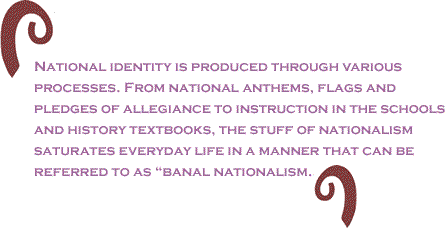
Since at least 1994 (the extent of my own collection) the
MOC’s Magazine and newsletters consistently present
the Confederacy in the same way. Its politics, propagation
of white supremacy and unequivocal support for slavery
are buried under artifacts, anecdotes, trivia, curiosities,
personal interest stories and drowned in nostalgia. The
Magazine’s articles are not employed to tell the
story of the Confederacy, rather, they distract from it.
Without such context, the reader is invited to identify with
the people described and empathize not just with them
but also, implicitly, their goals. The individuals described
in MOC Magazine articles were human beings and
often suffered, so it is important to see them as people.
Yet, the great wrongs in human history are frequently
not done by raving monsters but people, ordinary people
in their everyday lives. However, the MOC Magazine
articles never generate a sense of the tragedy of
these people who believed in what they are doing, but
what they believed in and what they did in the name of
the Confederacy was attempt to preserve white supremacy
and the enslavement of millions. Their self-interest in
supporting the Confederacy is overlooked; in MOC Magazine
articles, the Civil War is being fought, but why
is obscured. MOC Magazine, clogged with endless
anecdotal stories, artifacts, curiosities and paintings,
has no room (or no desire) to explore the larger story
of the Confederacy; race and slavery are blocked out but
there is an article about the making of Robert E. Lee
nutcrackers for sale by the MOC.
[71] As John Urry comments in his book The
Tourist Gaze, “There is an absolute distinction between
authentic history (continuing and therefore dangerous)
and heritage (past, dead and safe). The latter, in short,
conceals social and spatial inequalities, mask a shallow
commercialism and consumerism, and may in part at least
destroy elements of the building or artifacts supposedly
being conserved. … Heritage is bogus history.”
[72]
Perhaps every biographical story in MOC Magazine doesn’t
need to include a reference to slavery and white supremacy
and race, but the issue of slavery, white supremacy, and
race must be part of the story of the Confederacy in the
MOC Magazine since it was the reason for the Confederacy’s
existence. The story of the Confederacy isn’t just old
uniforms and anecdotes. It is the story of the massacre
of African American Union troops at Poison Springs, Fort
Pillow, Olustee, and elsewhere. It is the story of slaves
escaping to Union lines. It is the story of rage against
the Emancipation Proclamation. It is the story of the
capture of free blacks by Confederate armies in Pennsylvania
to be sold into slavery. It is the story of resistance
of communities to being part of the Confederacy from western
Virginia’s counties becoming the state of West Virginia,
resistance in East Tennessee, to the story of Jones County.
It is the story of former slaves joining the Union army.
It is the story of bread riots and draft resistance. It
is the story of the persecution and murder of dissidents,
such as the Great Hanging at Gainesville in North Texas.
It is the story of emancipation as Union armies reach
communities. It is the story of slave owners shocked that
their slaves really didn’t love them.
The MOC may claim that they are just telling the stories
of their artifacts, holdings and human interest; if so,
they are choosing to be bound by their artifacts and these
stories to romanticize the Confederacy, but not be historically
instructive. The MOC Magazine’s stories understands
the collection as relics and stay within a framework
of a sacred Confederacy, one that can be consumed as a
national identity by visitors, members, viewers, and readers.
Thus, the MOC is failing the public. In particular, they
are failing those in the former Confederate states by
binding them to a mythical, sacred, revered Confederate
nation rather than helping them to process this historical
experience, and understand it in a way that enables the
nineteenth Century slave-holding Confederacy to be left
behind, thus allowing residents of former Confederate
states to both share in the future of the United States’
multiracial democracy, and be cosmopolitans in a multipolar
world.
Click here to
read any of the parts in this series.

BlackCommentator.com
Guest Commentator, Edward H. Sebesta, is co-editor of
Neo-Confederacy: A Critical Introduction (University of
Texas, 2008) and The Confederate and Neo-Confederate
Reader: The ‘Great Truth’ of the ‘Lost Cause’ (University
Press of Mississippi, 2010) Click here
to contact Mr. Sebesta.
[1] An overview of theories of nationalism
is beyond the scope of this essay. For reading on the
theory of nationalism, good books to start with are Benedict
Anderson, “Imagined Communities,” 2nd Edition,
Verso London, 2006 and Eric Hobsbawn and Terence Ranger,
“The Invention of Tradition,” Cambridge Univ. Press, Cambridge,
1992.
[2] Michael Billig, “Banal Nationalism,”
Sage Publications, London, 1995.
[3] Prösler, Martin, “Museums and Globalization,”
in “Theorizing Museums,” edited by Sharon Macdonald and
Gordon Fyfe, “ Blackwell Publishers, Oxford, 1996, pages
21-44, quotation on page 35.
[4] Kaplan, Flora E.S., editor, “Museums
and the Making of ‘Ourselves’: The Role of Objects in
National Identity,” Leicester University Press, London
1994.
[5] Fladmark, J.M.
editor, “Heritage & Museums: Shaping National Identity,”
Donhead Publishing, Shaftesbury (England), 2000.
[6] If the Museum of the Confederacy
tried to be the Museum of the Civil War in the American
South it would just be a Museum of the Confederacy by
another indirect name. What is the South? See www.templeofdemocracy.com/breaking.htm.
[8] Coski, John M., “Many ‘Southerners
of Jewish Persuasion’ Embraced the Confederate Cause,”
The Museum of the Confederacy Magazine, Spring 2011.
[9] Wright, Catherine M., “Flag Conservation
Donors Bring Banners Back to Life,” The Museum of the
Confederacy Magazine, Winter 2010.
[10] No author, “Two Major Fundraising
Projects Reach Milestones,” The Museum of the Confederacy
Magazine, Spring 2008, page 28.
11Coski, John M., “Support from Organizations
Build Firm Foundation for Museum & White House Projects,”
The Museum of the Confederacy Magazine, Summer
2009, pages 18-19.
[12] Rose, Rebecca, “Flag Sponsorships:
‘In the presence of the noble colors,’” The Museum
of the Confederacy Magazine,” Winter 2006, pages 16-17.
[13] “A ‘Bright and Lasting’ Tribute:
The Conservation of the Caroline Greys Flag,”
[14] “Hollywood” referred to here is
not the Hollywood in California, but a cemetery in Richmond,
Virginia.
[15] Wright, Catherine, “A ‘Bright and
Lasting’ Tribute: The Conservation of The Caroline Greys
Flag,” The Museum of the Confederacy Magazine,
Summer 2011, pages 12-15.
[16] Kidd, Henry E., “The Museum of the
Confederacy: Future in Doubt?,” Confederate Veteran, Nov./Dec.
2004, pages 16,17, 48.
[17] No author, The Museum of the
Confederacy Magazine, Winter 2008, page 3.
[18] In the following references I have
given just one instance of it being offered, but often
the items were offered repeatedly in the magazine. Additionally
many could be found in their online store at the MOC’s
online Haversack Store. http://01f78b5.netsolstores.com/.
[19] No author, Haversack Store Catalog,
The Museum of the Confederacy Magazine, Fall 2007,
page 37.
[20] No author, Haversack Store Catalog,
The Museum of the Confederacy Magazine, Summer
2007, page 30.
[21] No author, Haversack Store Catalog,
The Museum of the Confederacy Magazine, Summer
2007, page 31.
[22] No author, Haversack Store Catalog,
The Museum of the Confederacy Magazine, Winter
2006, page 22.
[23] No author, Haversack Store Catalog,
The Museum of the Confederacy Magazine, Winter
2006, page 22.
[24] No author, Haversack Store Catalog,
The Museum of the Confederacy Magazine, Fall 2006,
page 28.
[25] No author, Haversack Store Catalog,
The Museum of the Confederacy Magazine, Fall 2005,
page 37.
[26] No author, Haversack Store Catalog,
The Museum of the Confederacy Magazine, Summer
2005, page 28.
[27] No author, Haversack Store Catalog,
The Museum of the Confederacy Magazine, Winter
2010, page 21.
[28] No author, Haversack Store Catalog,
The Museum of the Confederacy Magazine, Winter
2010, page 21.
[29] No author, Haversack Store Catalog,
The Museum of the Confederacy Magazine, Fall 2009,
page 34
[30] No author, Haversack Store Catalog,
The Museum of the Confederacy Magazine, Summer
2009, page 23.
[31] No author, Haversack Store Catalog,
The Museum of the Confederacy Magazine, Summer
2009, page 23.
[32] No author, Haversack Store Catalog,
The Museum of the Confederacy Magazine, Summer
2009, page 22.
[33] No author, Haversack Store Catalog,
The Museum of the Confederacy Magazine, Winter
2009, page 30.
[34] No author, Haversack Store Catalog,
The Museum of the Confederacy Magazine, Winter
2009, page 29.
[35] No author, Haversack Store Catalog,
The Museum of the Confederacy Magazine, Fall 2010,
page 37.
[36] No author, Haversack Store Catalog,
The Museum of the Confederacy Magazine, Summer
2009, page 22.
[38] No author, Haversack Store Catalog,
The Museum of the Confederacy Magazine, Fall 2006,
page 38.
[39] No author, Haversack Store Catalog,
The Museum of the Confederacy Magazine, Winter
2006, page 21.
[40] No author, Haversack Store Catalog,
The Museum of the Confederacy Magazine, Fall 2010, page
36; Winter 2011, page 30; Spring 2011, page 28.
[41] No author, Haversack Store Catalog,
The Museum of the Confederacy Magazine, Fall 2007,
page 37 and Fall 2009, page 34.
[42] No author, Haversack Store Catalog,
The Museum of the Confederacy Magazine, Summer
2009, page 22.
[43] No author, Haversack Store Catalog,
The Museum of the Confederacy Magazine, Winter
2009, page 28.
[44] No author, Haversack Store Catalog,
The Museum of the Confederacy Magazine, Winter
2009, page 30.
[46] No author, Haversack Store Catalog,
The Museum of the Confederacy Magazine, Winter/Spring
2007, pages 29-31.
[48] No author, Haversack Store Catalog,
The Museum of the Confederacy Magazine, Winter
2006, pages 19-23.
[49] No author, Haversack Store Catalog,
The Museum of the Confederacy Magazine, Fall 2007,
pages 34-39.
[50] No author, Haversack Store Catalog,
The Museum of the Confederacy Magazine, Spring
2007, pages 27-31.
[51] No author, Haversack Store Catalog,
The Museum of the Confederacy Magazine, Winter
2009, pages 28-31.
[52] No author, Haversack Store Catalog,
The Museum of the Confederacy Magazine, Spring
2009, pages 19-22.
[53] No author, Haversack Store Catalog,
The Museum of the Confederacy Magazine, Summer
2009, pages 21-23.
[54] No author, Haversack Store Catalog,
The Museum of the Confederacy Magazine, Winter
2010, pages 20-23.
[55] No author, Haversack Store Catalog,
The Museum of the Confederacy Magazine, Winter
2011, pages 28-31.
[57] Wharton, Annabel Jane, “Selling
Jerusalem: Relics, Replicas, Theme Parks,” Univ. of Chicago
Press, Chicago, 2006, page 50.
[58] Wharton, Annabel Jane, “Selling
Jerusalem: Relics, Replicas, Theme Parks,” Univ. of Chicago
Press, Chicago, 2006, pages 9-10.
[59] Coski, John M., ‘President Theodore
Roosevelt Made a Pilgrimage to the Confederate Museum,”
The Museum of the Confederacy Newsletter, Spring/Summer
2004, pages 7-8.
[60] Coski, John M.,
“The Museum & White House of the Confederacy,” UDC
Magazine, Vol. 65 Nol. 7, August 2002, page 10.
[61] Advertisement of
the Museum of the Confederacy, inside back cover, no author,
UDC Magazine, Sept. 1994.
[62] Kidd, Henry E.,
“The Museum of the Confederacy: Future in Doubt?,” Confederate
Veteran, Nov./Dec. 2004, pages 16, 17, 48.
[63] For sources on relics I recommend,
“Selling Jerusalem: Relics, Replicas, Theme Parks,” by
Annabel Jane Wharton, University of Chicago Press, Chicago,
2006; “Christian Materiality: An Essay on Religion in
Late Medieval Europe,” by Caroline Walker Bynum, Zone
Books, New York, 2011; “The Way to Heaven: Relic veneration
in the Middle Ages,” Henk van Os, de Prom, Baarn, 2000.
[64] Wharton, Annabel Jane, “Selling
Jerusalem: Relics, Replicas, Theme Parks,” Univ. of Chicago
Press, Chicago, 2006, pages 22-27.
[65] Coski, John M., Collier Malinda
W., “The Museum of the Confederacy’s Robert E. Lee Collection,”
The Museum of the Confederacy Journal, No. 76,
no date, with “An Interpretive Essay” by Emory M. Thomas.
[66] Johnson, Lawrence C., “Notes Upon
‘Moral Discoveries in Africa,’” The New Eclectic Magazine
, Vol. 7, Nov. 1870, pages 590-603, reference on page
594. This magazine has several articles like this that
just sicken the author.
[67] Parsons, Barbara Buchanan, “Confederate
History Compendium of Tennessee,” published by the Tennessee
Division United Daughters of the Confederacy, Knoxville
2010, pages 319-22.
[68] Coski, Ruth Ann, “Rich Collections
Attest to Family Ties of Three Confederate Generals,”
Museum of the Confederacy Magazine, Spring 2010, pages
6-13.
[69] Coski, John M., “Stroll Through
The Streets or Through The Collections to Meet The Women
of Wartime Richmond,” Museum of the Confederacy Magazine,
Spring 2010, pages 14-17.
[70] Coski, Ruth Ann, “Antebellum Scrapbook
Reveals ‘Flowering’ of Young J.E.B. Stuart,” Museum of
the Confederacy Magazine, Winter 2010, pages 16-19.
[72] Urry, John, “The Tourist Gaze,”
2nd Ed., Sage Pub. London, 2002, page 99. Though
Urry is commenting on museums in Britain its applicability
to the MOC seems particularly appropriate.
|
| |
|
| |
|
| |
|
| |
|
| |
|
If you send
us an emaill message we may publish all or part
of it, unless you tell us it is not for publication.
You may also request that we withhold your name.
Thank you
very much for your readership.
|
| |
|
| |
|
| |
|
| Mar 1, 2012 - Issue 461 |
 is
published every Thursday
is
published every Thursday |
| Est. April 5, 2002 |
Executive Editor:
David A. Love, JD |
Managing Editor:
Nancy Littlefield, MBA |
Publisher:
Peter Gamble |
| |
|
|
| |
|
|
|
| |
| |
| |
| |
| |
| |
| |
| |
| |
| |
|
|

